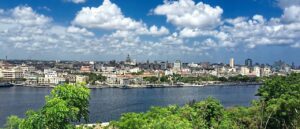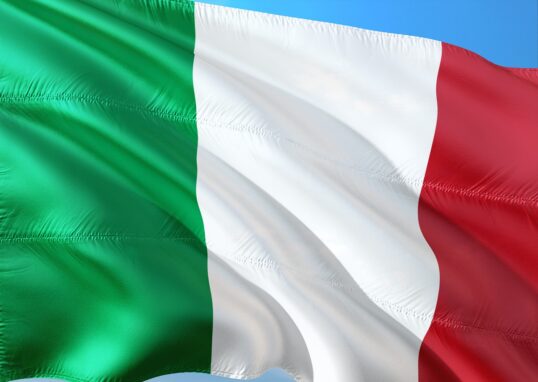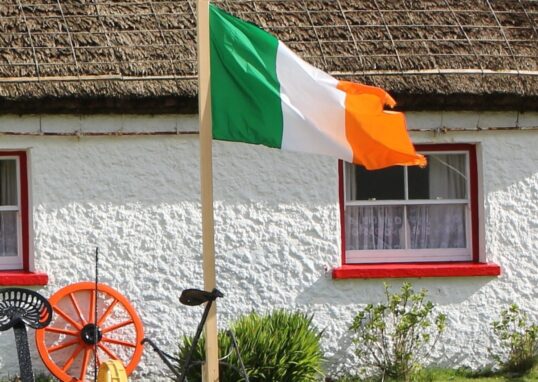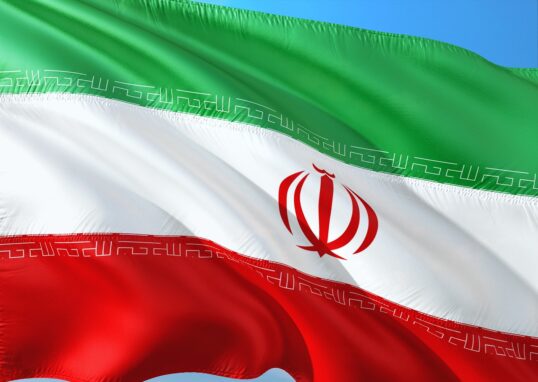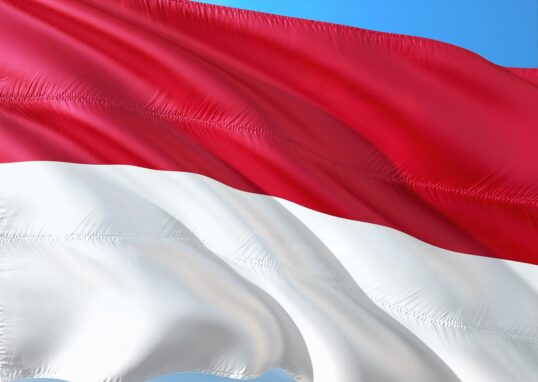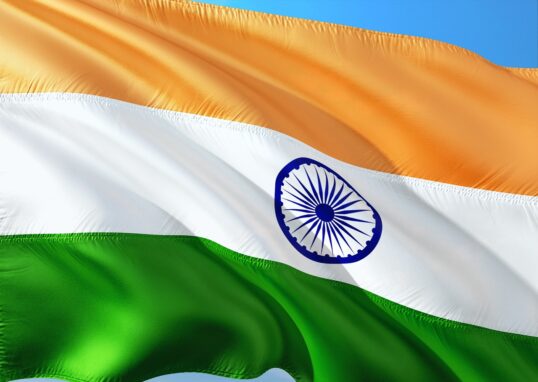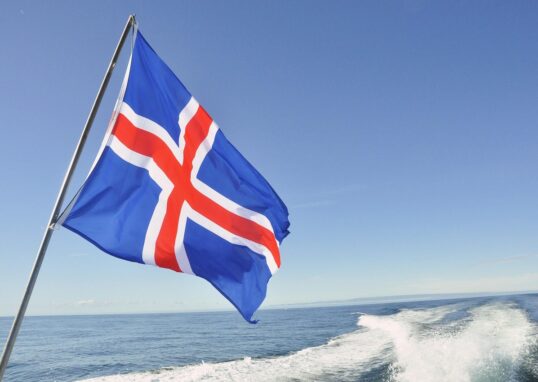
Cuba – The Heart of the Caribbean
Cuba is one of the most interesting islands in the Caribbean. It lies between the Gulf of Mexico and the Atlantic Ocean. This country is famous for its tropical beauty, warm people, rich history, and lively culture. Upon entering Cuba, you seem to walk through a mix of past and present: streets full of old cars, colorful houses, and the sound of music. Cuba is the largest island in the Caribbean. It has over 1,200 kilometres of coastline, white beaches, and clear waters. The country long connected North and South America. Its culture shows Spanish, African, and Caribbean traces. The island is full of charm, with historic cities, tobacco farms, old colonial towns, and friendly locals. It is due to this particular blend of history, nature, and music that Cuba attracts millions of travelers each year. 
Geography of Cuba
uba is long and narrow. It stretches about 1,250 kilometers from west to east but is only about 100 kilometers wide on average. One main island and several smaller ones called the “Isles of Youth” comprise the country. The land is filled with mountains, plains, and valleys. The eastern part is the site of the Sierra Maestra mountain range, with the highest point being the nearly 1,974-meter Pico Turquino. These mountains are full of forests and wildlife. In the west, the Viñales Valley is famous for its limestone hills called “mogotes.” Cuba has a tropical climate. There are two main seasons in the year: the dry season, from November to April, and the wet season, from May to October. Sometimes hurricanes visit the island between August and October. The sun, nonetheless, shines almost throughout the year.
A Glimpse of History
Cuba’s history stretches back thousands of years. Before the Europeans arrived, there existed a population of Indigenous peoples, including the Taíno and Ciboney. They lived peacefully, cultivating and fishing. Christopher Columbus landed on the island in 1492 during his first voyage. He claimed Cuba for Spain. Soon after, Spanish settlers built towns and plantations. Indigenous people were forced to work in conditions very harmful to them, and many died due to diseases and hardships. It was during the 16th and 17th centuries that Havana became an important port for Spanish ships. Pirates commonly attacked it as a result of its wealth. Later, enslaved Africans were brought to Cuba to work on sugar and tobacco plantations. This created a deep African influence on Cuban culture that remains strong today. During the 1800s, Cubans fought for their independence from Spain. The people were inspired by leaders such as José Martí. It wasn’t until after the Spanish-American War of 1898 that Cuba won its independence in 1902. However, the United States still had control over Cuban politics and business.
In 1959, a revolution, led by Fidel Castro and Ernesto “Che” Guevara, changed the island forever. The revolution replaced the old government with a socialist system. Since then, Cuba has had close relations with socialist countries like the former Soviet Union and often had tense relations with the United States. 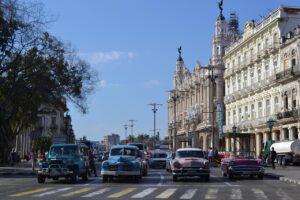
People and Society
Cuba is a country with a population of roughly 11 million. Most of them have mixed heritage: a mix of Spanish, African, and Indigenous backgrounds. Spanish is the official language, but it has a typical Cuban accent and slang that makes it different and musical. Cubans are a warm and friendly people. Family life is the center of society. Neighbors help each other, and communities are close-knit. Education is free and literacy rates are among the highest in the world. Healthcare is also free, and it is considered that Cuba has some of the best doctors and nurses worldwide; many Cuban doctors work abroad in medical aid programs. Religion plays a role too. Most Cubans are Roman Catholic, but African traditions such as Santería are also common. Santería combines Catholic saints with African spiritual beliefs, creating colorful rituals, drumming, and dances. It is everywhere, from the smallest towns to Havana’s streets, with the rhythms of salsa, mambo, rumba, and son. The dance is a way of life, and Cuban music has influenced Latin rhythms across the world.
Major Cities
Havana
Havana is both Cuba’s capital and largest city, located on the northern coast facing the Gulf of Mexico. The famous city is known for its old Spanish buildings, cobblestone streets, and classic 1950s American cars. Old Havana, or Habana Vieja, is a UNESCO World Heritage Site. Here, you will find brightly colored buildings, lively plazas, and old fortresses such as the Castillo del Morro and La Cabaña. The Malecón-the long seaside promenade-is one of the best places to watch the sunset. Havana at night is full of music, dancing, and joy. 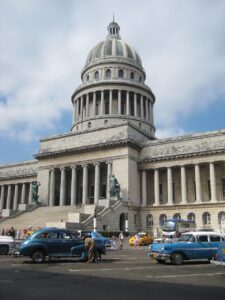
Santiago de Cuba
Santiago de Cuba is in the southeast and is the island’s second-largest city. It is known for its vibrant Afro-Cuban culture and festivals such as the Carnival of Santiago. The city played an important role during Cuba’s revolution and in the struggles of the country toward its independence.
Trinidad
Trinidad is a small city frozen in time. Its cobbled streets and pastel-colored houses make it one of Cuba’s most beautiful towns. It is also a UNESCO World Heritage Site. Nearby, the Valle de los Ingenios (Valley of the Sugar Mills) shows the history of sugar production in the 18th and 19th centuries.
Viñales
Viñales is based in western Cuba amidst dramatic limestone hills. It’s especially famous for tobacco farms where cigars are hand-made. Visitors come to explore caves, farms, and hiking trails.
Varadero
Varadero is one of the most popular beach resorts in the Caribbean because it has 20 kilometers of white sand with turquoise water. Some of the most important international hotels are located here.
Economy of Cuba
Cuba possesses a mixed economy and is mainly state-controlled. Main industries include agriculture, tourism, biotechnology, and mining. For centuries, sugar was Cuba’s leading export. Tobacco is also a key product. Cuban cigars are world-famous for their quality. Coffee, rum, and tropical fruits are important too. The country also produces nickel, cobalt, and other minerals. More recently, Cuba developed a strong biotechnology and medical research industry. Vaccines and medicines are Cuban products exported to many countries. Scarce resources and the U.S. trade embargo in place since the 1960s have imposed burdens on the economy, though Cubans resourcefully and creatively make the best use of what they have.
Culture and Daily Life
Colorful and expressive, Cuban culture combines Spanish elegance, African rhythm, and Caribbean joy. Art, music, and literature are everywhere. Salsa, rumba, cha-cha-cha, and bolero are part of daily life. Instruments like bongos, maracas, and guitars fill the air with rhythm. Cuba’s National Ballet is world-famous, and Cuban jazz is loved by musicians around the globe.
Nature and Environment
Cuba is rich in natural beauty, with national parks, mountains, forests, and coral reefs. About 20% of the country is protected land. The Alejandro de Humboldt National Park is designated as a UNESCO World Heritage site with rare flora and fauna species. The Zapata Swamp, one of the largest wetlands in the Caribbean, is home to crocodiles, flamingos, and many other bird species. The Viñales Valley is another UNESCO site; its topography comprises hills made up of limestone and contains caves. Nature and farming combined result in stunning scenery.
Tourism in Cuba – The Island of Rhythm and Beauty
Cuba is probably the most charming place in the Caribbean; a perfect mix of sunshine, history, and culture. It remains one of those dream places to people who love traveling. The charm of the island is in its people, its old streets, and its timeless energy. Tourism in Cuba is much more than beaches; it’s about rhythm, color, and life. Every city, valley, and village has its own story. From the capital Havana to the peaceful countryside of Viñales, Cuba offers a full range of experiences that touch both the heart and mind.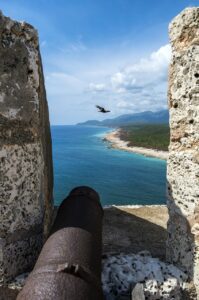
The Growth of Tourism
Tourism has become the backbone of the Cuban economy. The government has been developing many resorts, hotels, and eco-tourism areas over recent decades. Visitors come from all over the world, especially from Canada, Europe, and Latin America. Cuba started seriously promoting tourism after the 1990s. It was during the so-called “Special Period” when the fall of the Soviet Union affected the Cuban economy.
Havana – The Heart of Culture
The capital, Havana, is the soul of Cuba: full of music, laughter, and stories about times past. The old part of Havana (La Habana Vieja) is a UNESCO World Heritage Site; it contains colorful colonial buildings and cobblestone streets. Tourists love visiting the plazas: Plaza Vieja, Plaza de la Catedral, and Plaza de Armas. Every one of them is surrounded by museums, cafes, and street performers. The Malecon is the seafront boulevard of Havana, extending for eight kilometers. Locals come here to talk, play music, and watch the sunset.
Varadero – The Beach Paradise
Just two hours from Havana lies Varadero, one of the most beautiful beaches in the world. Its 20-kilometer stretch of white sand and turquoise water makes it a perfect resort destination. Varadero features luxurious hotels, all-inclusive resorts, and beaches suitable for family visits. It is an excellent spot for swimming, sunbathing, and water sports. Snorkeling and diving are very popular owing to the coral reefs and clear waters. Nearby is the Josone Park, a quiet garden filled with lakes, bridges, and tropical plants. There are also caves, such as the Cueva de Ambrosio, where ancient Indigenous paintings can still be viewed.
Viñales Valley – The Land of Tobacco and Mountains
The Viñales Valley presents a wholly different experience in western Cuba. It is a countryside bounded by mogotes, or limestone hills. The landscape is of such beauty that it has been listed as a UNESCO World Heritage Site. Tobacco farms dot the countryside around Viñales. Farmers grow and dry the leaves that go into Cuba’s famous cigars, a process visitors can see firsthand by walking or horseback riding through the farms. The valley also has caves, like the Cueva del Indio, where you will be able to take an underground river trip by boat. From the peaceful countryside to friendly farmers, Viñales is the perfect place to just relax and enjoy Cuba’s natural side.
Trinidad – A Journey Back in Time
The town of Trinidad is one of Cuba’s treasures. Walking down its narrow streets, one feels as though he has been transported to the 18th century. The pastel-colored houses and cobblestone roads are perfectly preserved. Museums, churches, and colonial homes surround the main square of Trinidad, Plaza Mayor, while at night, its steps are filled with music as people dance onto the sounds from Casa de la Música. Not far away is the Valle de los Ingenios, or Valley of the Sugar Mills, where hundreds of plantations used to exist. Visitors today can still see old mills, lookout towers, and plantation houses that document the history of Cuba’s sugar industry.
Santiago de Cuba – The City of Music and Revolution
Santiago de Cuba, situated in eastern Cuba, is known for its strong Afro-Cuban culture and revolutionary history. Music is the heartbeat of the city. It is the birthplace of numerous Cuban rhythms that include the likes of son and trova. The visitors can have sights of the Castillo del Morro, the huge fortress guarding Santiago’s bay; the Revolution Square and Moncada Barracks-the city’s importance in Cuba’s political history. Every July, the city of Santiago hosts one of the most colorful festivals in the Caribbean, the Carnival of Santiago de Cuba. Streets are filled with colorful costumes, drummers, dancers, and overall joy.
Cienfuegos and Santa Clara – Culture and Memory
Cienfuegos, also referred to as “The Pearl of the South,” is renowned for its French-inspired architecture and tranquil atmosphere. The main city square, Parque José Martí, is filled with stunning buildings, including the Terry Theater and the Cathedral of the Immaculate Conception. Close by, Santa Clara is renowned for being associated with the revolutionary leader, Che Guevara.
The Islands and Cays – Cuba’s Hidden Paradise
Apart from the main island, Cuba also has hundreds of small islands and cays. Among them, the best-known are Cayo Coco, Cayo Guillermo, Cayo Santa María, and Cayo Largo del Sur. These islands are famous for their crystal-clear water, coral reefs, and white sandy beaches. Plenty of eco-resorts and luxurious hotels function here. They are perfect for snorkeling, diving, and relaxing in peace. These are marine protected areas, representing some of the best dive sites in the Caribbean: the Jardines del Rey (Gardens of the King) and Jardines de la Reina (Gardens of the Queen).
Surrounding Places and Neighboring Regions
Beautiful Caribbean neighbors surround Cuba. To the north is Florida in the United States across from the Straits of Florida. Northeast of Cuba is the Bahamas. To the east lies Haiti and the Dominican Republic on the island of Hispaniola. To the south is Jamaica, and to the west is Mexico’s Yucatán Peninsula. The surrounding seas are rich in marine life. The Gulf of Mexico and the Caribbean Sea bring warm waters, which make Cuba’s beaches inviting all year round. Because of its position, Cuba is a cultural bridge in the Caribbean: many ships pass its waters, and trade routes once linked Havana to Spain, Africa, and the Americas. Each of the surrounding countries also shares a common historical and cultural tradition with Cuba. For instance, Jamaica and the Dominican Republic share quite similar rhythms in music and cuisine. The large Cuban community in Florida keeps these cultural connections alive. Travelers visiting Cuba often include nearby destinations like Cancun in Mexico, Nassau in the Bahamas, or Santo Domingo in the Dominican Republic. These nearby areas create a regional tourism network full of history and sunshine.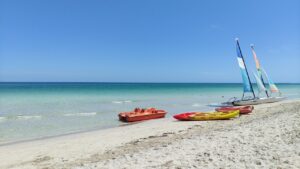
Challenges and the Future
However, the people of Cuba are strong and optimistic; they love education, culture, and unity. Many young Cubans are creative, starting small businesses like cafes and art galleries to share their culture with the world. Tourism keeps on expanding, offering new horizons. Cultural exchanges, eco-tourism, and heritage projects enable it to develop sustainably.
Why Visit Cuba
There is something that no other country can boast of, and that is Cuba. It is as if time comes to a standstill here. Old colonial buildings, vintage cars, and street music create an atmosphere full of character. Here are a few reasons to visit Cuba:
- Friendly and approachable people. Rich history and colonial architecture. Lively music and dance culture. Beautiful beaches and national parks.
Conclusion
It’s not merely an island but a living story of courage, beauty, and rhythm. From the cobbled streets of Havana to the tobacco farms of Viñales, every single corner tells a tale. It has faced many adversities, but its people never lose their spirits. Hope and pride are reflected in their smiles, songs, and dances. Washed by turquoise seas and flanked by the neighboring Caribbean islands, Cuba shines bright in culture and resilience. When you visit Cuba, you don’t just see a country-you feel its heartbeat. The sound of the drums, the scent of cigars, the glow of the sunset along the Malecon-they all remind you that Cuba is timeless. Cuba is not a destination; it’s an experience, a rhythm, and a memory that etches in the heart of tourists forever.
